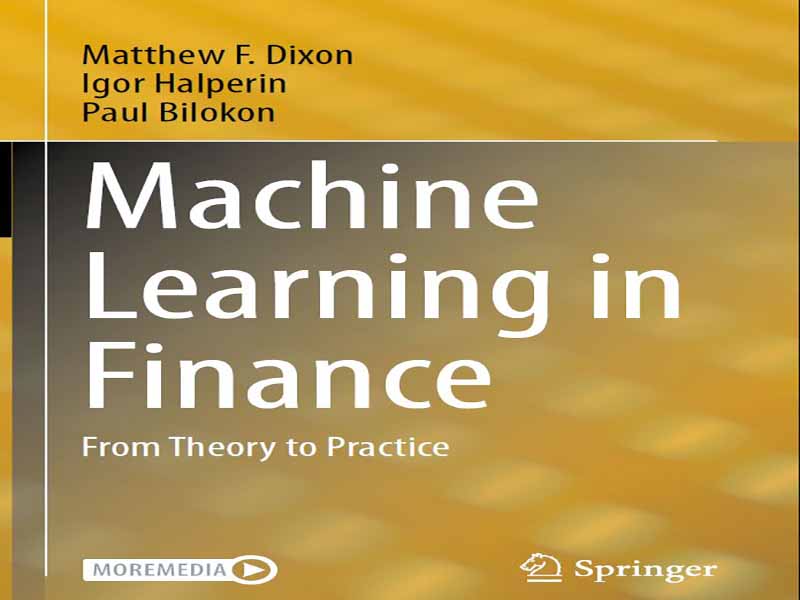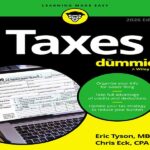- عنوان کتاب: Machine Learning in Finance
- نویسنده: Matthew F. Dixon
- حوزه: یادگیری ماشین
- سال انتشار: 2020
- تعداد صفحه: 300
- زبان اصلی: انگلیسی
- نوع فایل: pdf
- حجم فایل: 4.97 مگابایت
یادگیری ماشین در امور مالی در تقاطع تعدادی از رشته های نوظهور و تثبیت شده از جمله تشخیص الگو، اقتصاد سنجی مالی، محاسبات آماری، برنامه ریزی احتمالی و برنامه نویسی پویا قرار دارد. با گرایش به افزایش منابع محاسباتی و مجموعه دادههای بزرگتر، یادگیری ماشین به یک حوزه مهندسی محاسباتی مرکزی تبدیل شده است، با تاکید بر الگوریتمهای plug-and-play که از طریق ابزارهای یادگیری ماشین منبع باز در دسترس هستند. حوزه های مالی متمرکز بر الگوریتم، مانند تجارت الگوریتمی، پذیرندگان اصلی این فناوری بوده اند. اما خارج از گروههای تحقیقاتی مبتنی بر مهندسی و فعالیتهای تجاری، بسیاری از این زمینه همچنان یک راز باقی مانده است.
یک مانع کلیدی برای درک یادگیری ماشین برای دانشجویان و شاغلین غیرمهندسی، فقدان تئوری ها و مفاهیم به خوبی تثبیت شده است که تجزیه و تحلیل سری های زمانی مالی ما را به آنها مجهز می کند. اینها به عنوان پایه ای برای توسعه شهود مدل سازی مالی و استدلال علمی عمل می کنند. علاوه بر این، یادگیری ماشین به شدت در هستی شناسی مهندسی ریشه دوانده است، که باعث می شود پیشرفت ها در این زمینه تا حدودی از نظر فکری برای دانش آموزان، دانشگاهیان و متخصصان مالی از رشته های کمی مانند ریاضیات، آمار، فیزیک و اقتصاد غیرقابل دسترس باشد. در نتیجه، تصور غلط و درک محدودی از ظرفیت این حوزه وجود دارد. در حالی که تکنیکهای یادگیری ماشینی اغلب مؤثر هستند، هنوز درک درستی ندارند و اغلب از نظر ریاضی غیرقابل دفاع هستند. چگونه مفاهیم کلیدی را در زمینه یادگیری ماشین در زمینه تئوری بنیادی تر در تجزیه و تحلیل سری های زمانی، اقتصاد سنجی و آمار ریاضی قرار دهیم؟ تحت کدام شرایط سادهسازی، تکنیکهای پیشرفته یادگیری ماشین مانند شبکههای عصبی عمیق از نظر ریاضی با مدلهای آماری معروف مانند رگرسیون خطی معادل هستند؟ چگونه باید در مورد مزایای درک شده استفاده از روشهای یادگیری ماشینی پیشرفته نسبت به روشهای اقتصاد سنجی سنتی، برای کاربردهای مالی مختلف استدلال کنیم؟ چه نظریهای از کاربرد یادگیری ماشین برای مشکلات مدلسازی مالی پشتیبانی میکند؟ چگونه یادگیری تقویتی یک رویکرد بدون مدل به مدل بلک-اسکولز-مرتون برای قیمت گذاری مشتق ارائه می کند؟ یادگیری Q چگونه مشکلات کنترل تصادفی زمان گسسته را در امور مالی تعمیم می دهد؟
این کتاب برای دانشجویان کارشناسی ارشد پیشرفته و دانشگاهیان در اقتصاد سنجی مالی، علوم مدیریت و آمار کاربردی، علاوه بر دانشمندان کمیت و داده در زمینه مالی کمی نوشته شده است. ما یادگیری ماشینی را به عنوان یک بسط غیر خطی از موضوعات مختلف در اقتصاد کمی مانند اقتصاد سنجی مالی و برنامهریزی پویا، با تاکید بر نمایش الگوریتمی جدید دادهها، منظمسازی و تکنیکهای کنترل مبادله بایاس واریانس که منجر به بهبود خروجی میشود، ارائه میکنیم. پیش بینی نمونه این کتاب در سه بخش ارائه شده است که هر بخش تئوری و کاربردها را پوشش می دهد. بخش اول یادگیری نظارت شده را برای داده های مقطعی از هر دو دیدگاه بیزی و مکرر ارائه می کند. مواد پیشرفته تر تاکید جدی بر شبکه های عصبی، از جمله یادگیری عمیق، و همچنین فرآیندهای گاوسی، با مثال هایی در مدیریت سرمایه گذاری و مشتقات دارد. بخش دوم یادگیری نظارت شده برای داده های سری زمانی را پوشش می دهد، که احتمالاً رایج ترین نوع داده مورد استفاده در امور مالی با مثال هایی در تجارت، نوسانات تصادفی و مدل سازی درآمد ثابت است. در نهایت، بخش سوم یادگیری تقویتی و کاربردهای آن در تجارت، سرمایه گذاری و مدیریت ثروت را پوشش می دهد. ما نمونههای کد پایتون را برای حمایت از درک خوانندگان از متدولوژیها و برنامهها ارائه میکنیم. به عنوان پلی برای تحقیق در این زمینه نوظهور، ما مرزهای یادگیری ماشین در امور مالی را از دیدگاه یک محقق ارائه میکنیم، و نشان میدهیم که چه تعداد از مفاهیم شناخته شده در فیزیک آماری احتمالاً به عنوان موضوعات تحقیقاتی برای یادگیری ماشین در امور مالی ظهور میکنند.
Machine learning in finance sits at the intersection of a number of emergent and established disciplines including pattern recognition, financial econometrics, statistical computing, probabilistic programming, and dynamic programming. With the trend towards increasing computational resources and larger datasets, machine learning has grown into a central computational engineering field, with an emphasis placed on plug-and-play algorithms made available through open-source machine learning toolkits. Algorithm focused areas of finance, such as algorithmic trading have been the primary adopters of this technology. But outside of engineering-based research groups and business activities, much of the field remains a mystery.
A key barrier to understanding machine learning for non-engineering students and practitioners is the absence of the well-established theories and concepts that financial time series analysis equips us with. These serve as the basis for the development of financial modeling intuition and scientific reasoning. Moreover, machine learning is heavily entrenched in engineering ontology, which makes devel-opments in the field somewhat intellectually inaccessible for students, academics, and finance practitioners from the quantitative disciplines such as mathematics, statistics, physics, and economics. Consequently, there is a great deal of miscon-ception and limited understanding of the capacity of this field. While machine learning techniques are often effective, they remain poorly understood and are often mathematically indefensible. How do we place key concepts in the field of machine learning in the context of more foundational theory in time series analysis, econometrics, and mathematical statistics? Under which simplifying conditions are advanced machine learning techniques such as deep neural networks mathematically equivalent to well-known statistical models such as linear regression? How should we reason about the perceived benefits of using advanced machine learning methods over more traditional econometrics methods, for different financial applications?What theory supports the application of machine learning to problems in financial modeling? How does reinforcement learning provide a model-free approach to the Black–Scholes–Merton model for derivative pricing? How does Q-learning generalize discrete-time stochastic control problems in finance?
This book is written for advanced graduate students and academics in financial econometrics, management science, and applied statistics, in addition to quants and data scientists in the field of quantitative finance. We present machine learning as a non-linear extension of various topics in quantitative economics such as financial econometrics and dynamic programming, with an emphasis on novel algorithmic representations of data, regularization, and techniques for controlling the bias-variance tradeoff leading to improved out-of-sample forecasting. The book is presented in three parts, each part covering theory and applications. The first part presents supervised learning for cross-sectional data from both a Bayesian and frequentist perspective. The more advanced material places a firm emphasis on neural networks, including deep learning, as well as Gaussian processes, with examples in investment management and derivatives. The second part covers supervised learning for time series data, arguably the most common data type used in finance with examples in trading, stochastic volatility, and fixed income modeling. Finally, the third part covers reinforcement learning and its applications in trading, investment, and wealth management. We provide Python code examples to support the readers’ understanding of the methodologies and applications. As a bridge to research in this emergent field, we present the frontiers of machine learning in finance from a researcher’s perspective, highlighting how many well-known concepts in statistical physics are likely to emerge as research topics for machine learning in finance.
این کتاب را میتوانید از لینک زیر بصورت رایگان دانلود کنید:
Download: Machine Learning in Finance



































نظرات کاربران